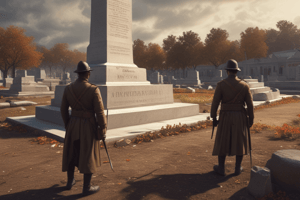Podcast
Questions and Answers
WWI କେନ୍ଦ୍ର ବଳ କିଏଥିଲା?
WWI କେନ୍ଦ୍ର ବଳ କିଏଥିଲା?
ଜର୍ମାନୀ, ଅଷ୍ଟ୍ରିଆ-ହଙ୍ଗେରୀ, ଓ ଓଟେମାନ ଟର୍କୀ
WWI କେନ୍ଦ୍ର ବଳରଙ୍ଗରେ କେଉ ଥିଲା?
WWI କେନ୍ଦ୍ର ବଳରଙ୍ଗରେ କେଉ ଥିଲା?
ଜର୍ମାନୀ ଏବଂ ତାଙ୍କ ସହଯୋଗୀ
WWI ଆରମ୍ଭ ହେଲ ଯେଦେଇ କାରଣରେ?
WWI ଆରମ୍ଭ ହେଲ ଯେଦେଇ କାରଣରେ?
ଆର୍ଚଡ୍ୱୁକ ଫ୍ରାନ୍ଜ ଫର୍ନାଣ୍ଡାଣଙ୍କ ହତ୍ୟା
WWI କେନ୍ଦ୍ର ବଳ କେଣେ ବିଶ୍ୱରେ ଭୂମଧ୍ୟ ଶାକ କରିଥିଲା?
WWI କେନ୍ଦ୍ର ବଳ କେଣେ ବିଶ୍ୱରେ ଭୂମଧ୍ୟ ଶାକ କରିଥିଲା?
WWI-ର ପୂର୍ବବର୍ତ୍ତୀ ଶତାବ୍ଦରେ, କେଉ ଥିଲା ଏଣ୍ଟେଣ୍ଟ ବଳରଙ୍ଗ?
WWI-ର ପୂର୍ବବର୍ତ୍ତୀ ଶତାବ୍ଦରେ, କେଉ ଥିଲା ଏଣ୍ଟେଣ୍ଟ ବଳରଙ୍ଗ?
କୌଣସି ଦିନରେ 'ଦ ବାଟଲେ ଅଫ୍ ଦ଼େ ସମ' ଏବଂ 'ଦ ଗ୍ରେଟ୍ ଗାଟ୍ସବି' ପ୍ରୋଥିବାାଦିକ କି ଲେଖାହେଇଛନ୍ତି?
କୌଣସି ଦିନରେ 'ଦ ବାଟଲେ ଅଫ୍ ଦ଼େ ସମ' ଏବଂ 'ଦ ଗ୍ରେଟ୍ ଗାଟ୍ସବି' ପ୍ରୋଥିବାାଦିକ କି ଲେଖାହେଇଛନ୍ତି?
Flashcards are hidden until you start studying
Study Notes
Charting History: World War I
In the first half of the 20th century, a conflict that would shake the world took shape. Known as World War I (WWI), this cataclysmic event spanned from 1914 to 1918 and forever altered the political, economic, and social landscape. Let's delve into the key events, players, and consequences of this unprecedented global conflict.
The Beginning: Archduke Franz Ferdinand's Assassination
The spark that ignited the powder keg of WWI was the assassination of Archduke Franz Ferdinand of Austria-Hungary on June 28, 1914, in Sarajevo by Gavrilo Princip, a member of the Serbian nationalist organization Black Hand. In response to this act, Austria-Hungary declared war on Serbia on July 28, 1914, and a domino effect of alliances ensued. Germany, Austria-Hungary's ally, declared war on France and Russia on August 3, 1914, while Russia mobilized its military and declared war on Austria-Hungary on August 6, 1914.
The Central Powers and the Entente Powers
World War I can be understood as a struggle between two coalitions of nations: the Central Powers and the Entente Powers. The Central Powers consisted of Germany, Austria-Hungary, and Ottoman Turkey, while the Entente Powers comprised France, Russia, Great Britain, and later Italy and the United States.
The Western Front and the Eastern Front
The Western Front, characterized by trench warfare, witnessed the clash of Germany and its allies against France and its allies, including Great Britain. The Eastern Front saw a conflict between Germany and its ally Austria-Hungary against Russia and its allies, including Romania.
The Battle of the Somme
The Battle of the Somme, which took place between July and November 1916, was a significant event on the Western Front. Initiated by the British, it resulted in over a million casualties, including 420,000 British soldiers wounded and 19,240 killed in a single day. The Battle of the Somme is a stark reminder of the human cost of the war.
Trench Warfare
Trench warfare, characterized by extensive systems of trenches and fortified positions, became a prominent feature of the Western Front. The trench lines, which were dug by soldiers on both sides, allowed for defensive fighting, resulting in high casualties as each side attempted to advance and break through the other's lines.
The Russian Revolution
The Russian Revolution, which overthrew the Romanov dynasty, played a significant role in the conclusion of WWI. Following the February Revolution in 1917, which led to the collapse of the Russian monarchy, Russia signed the Treaty of Brest-Litovsk in 1918. This treaty, which Russia ratified under duress, allowed Germany to focus its efforts on the Western Front.
The Armistice and the Treaty of Versailles
After years of bitter combat, Germany agreed to an armistice on November 11, 1918, which came into effect at 11:00 a.m. This armistice marked the end of active combat and paved the way for the Treaty of Versailles, which was signed on June 28, 1919, and imposed heavy penalties on Germany.
The Consequences of World War I
World War I fundamentally altered the global landscape. Its consequences included the collapse of the Austro-Hungarian, Ottoman, and Russian empires, the rise of communism, and the emergence of new nations such as Poland, Czechoslovakia, and Yugoslavia. It also led to the influenza pandemic of 1918 and set the stage for World War II.
Despite its grim legacy, World War I also fostered advancements in technology and medicine, including the discovery of penicillin and the development of blood transfusions. The war also led to notable literary and artistic works, such as "All Quiet on the Western Front" and "The Great Gatsby," which explore the human cost of conflict and the lives of those who lived through this dark era.
Although World War I was a tragedy, understanding its causes, consequences, and impact on the world is essential for appreciating the complexities of geopolitics, the human condition, and the fragility of peace.
Studying That Suits You
Use AI to generate personalized quizzes and flashcards to suit your learning preferences.




